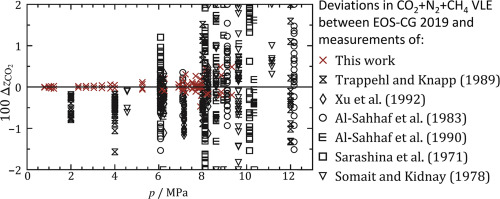当前位置:
X-MOL 学术
›
Fluid Phase Equilibr.
›
论文详情
Our official English website, www.x-mol.net, welcomes your feedback! (Note: you will need to create a separate account there.)
Thermodynamics of the carbon dioxide plus nitrogen plus methane (Co2 + N2 + Ch4) system: Measurements of vapor-liquid equilibrium data at temperatures from 223 to 298 K and verification of Eos-Cg-2019 equation of state
Fluid Phase Equilibria ( IF 2.6 ) Pub Date : 2020-04-01 , DOI: 10.1016/j.fluid.2019.112444 Sindre Ottøy , Tobias Neumann , Hans Georg Jacob Stang , Jana Poplsteinova Jakobsen , Anders Austegard , Sigurd Weidemann Løvseth
Fluid Phase Equilibria ( IF 2.6 ) Pub Date : 2020-04-01 , DOI: 10.1016/j.fluid.2019.112444 Sindre Ottøy , Tobias Neumann , Hans Georg Jacob Stang , Jana Poplsteinova Jakobsen , Anders Austegard , Sigurd Weidemann Løvseth

|
Abstract Vapor-liquid equilibria (VLE) data of the ternary mixture of CO2 + N2 + CH4 were measured at the isotherms 223 K, 253 K, 273 K, 283 K, and 298 K and for pressures in the range of 0.8 MPa–9.3 MPa. The 62 experimental dew or bubble point data points have been measured using an analytical technique. For each temperature, the ratio between N2 and CH4 mole fraction in the total composition has been close to constant, enabling the data to be visualized as quasi phase envelopes. Estimated standard measurement uncertainties (k = 1) better than 14 mK in temperature, 1.5 kPa in pressure, and 0.06 mol% in composition are reported, yielding a total uncertainty in terms of composition better than 0.07 mol%. The experimental data were compared to the EOS-CG-2019 model, which is a state-of-the-art Helmholtz energy-based equation of state for the mixture of CO2 + N2 + CH4. All deviations between model and experimental data points are below 0.5 mol% for liquid compositions and 1.0 mol% for vapor compositions. The deviations between model and experimental points in the ternary mixture of CO2 + N2 + CH4 follow the same trends seen in earlier reports between model and experimental data for the binary mixtures of CO2 + N2 and CO2 + CH4. In addition, the model was analysed with respect to other thermophysical properties available in the literature. To a large extent, the results presented in this work validate the assumption that the thermodynamic properties of the multicomponent system CO2 + N2 + CH4 can be described purely based on the pure component and binary mixture contributions.
中文翻译:

二氧化碳加氮气加甲烷 (Co2 + N2 + Ch4) 系统的热力学:223 至 298 K 温度下气液平衡数据的测量和 Eos-Cg-2019 状态方程的验证
摘要 CO2 + N2 + CH4 三元混合物的汽液平衡 (VLE) 数据在等温线 223 K、253 K、273 K、283 K 和 298 K 以及压力范围为 0.8 MPa–9.3 下测量兆帕。使用分析技术测量了 62 个实验露点或泡点数据点。对于每个温度,总成分中 N2 和 CH4 摩尔分数之间的比率接近恒定,使数据可视化为准相包络。估计的标准测量不确定度 (k = 1) 优于 14 mK 的温度、1.5 kPa 的压力和 0.06 mol% 的成分,产生的总成分不确定度优于 0.07 mol%。实验数据与EOS-CG-2019模型对比,这是 CO2 + N2 + CH4 混合物的最先进的基于亥姆霍兹能量的状态方程。模型和实验数据点之间的所有偏差对于液体成分均低于 0.5 mol%,对于蒸汽成分低于 1.0 mol%。CO2 + N2 + CH4 三元混合物的模型和实验点之间的偏差遵循与早期报告中 CO2 + N2 和 CO2 + CH4 二元混合物的模型和实验数据之间的相同趋势。此外,还针对文献中可用的其他热物理特性对模型进行了分析。在很大程度上,这项工作中呈现的结果验证了多组分系统 CO2 + N2 + CH4 的热力学性质可以完全基于纯组分和二元混合物贡献来描述的假设。模型和实验数据点之间的所有偏差对于液体成分均低于 0.5 mol%,对于蒸汽成分低于 1.0 mol%。CO2 + N2 + CH4 三元混合物中模型和实验点之间的偏差遵循与早期报告中 CO2 + N2 和 CO2 + CH4 二元混合物的模型和实验数据之间的相同趋势。此外,还针对文献中可用的其他热物理特性对模型进行了分析。在很大程度上,这项工作中呈现的结果验证了多组分系统 CO2 + N2 + CH4 的热力学性质可以完全基于纯组分和二元混合物贡献来描述的假设。模型和实验数据点之间的所有偏差对于液体成分均低于 0.5 mol%,对于蒸汽成分低于 1.0 mol%。CO2 + N2 + CH4 三元混合物中模型和实验点之间的偏差遵循与早期报告中 CO2 + N2 和 CO2 + CH4 二元混合物的模型和实验数据之间的相同趋势。此外,还针对文献中可用的其他热物理特性对模型进行了分析。在很大程度上,这项工作中呈现的结果验证了多组分系统 CO2 + N2 + CH4 的热力学性质可以完全基于纯组分和二元混合物贡献来描述的假设。CO2 + N2 + CH4 三元混合物中模型和实验点之间的偏差遵循与早期报告中 CO2 + N2 和 CO2 + CH4 二元混合物的模型和实验数据之间的相同趋势。此外,还针对文献中可用的其他热物理特性对模型进行了分析。在很大程度上,这项工作中呈现的结果验证了多组分系统 CO2 + N2 + CH4 的热力学性质可以完全基于纯组分和二元混合物贡献来描述的假设。CO2 + N2 + CH4 三元混合物中模型和实验点之间的偏差遵循与早期报告中 CO2 + N2 和 CO2 + CH4 二元混合物的模型和实验数据之间的相同趋势。此外,还针对文献中可用的其他热物理特性对模型进行了分析。在很大程度上,这项工作中呈现的结果验证了多组分系统 CO2 + N2 + CH4 的热力学性质可以完全基于纯组分和二元混合物贡献来描述的假设。根据文献中可用的其他热物理特性对模型进行了分析。在很大程度上,这项工作中呈现的结果验证了多组分系统 CO2 + N2 + CH4 的热力学性质可以完全基于纯组分和二元混合物贡献来描述的假设。根据文献中可用的其他热物理特性对模型进行了分析。在很大程度上,这项工作中呈现的结果验证了多组分系统 CO2 + N2 + CH4 的热力学性质可以完全基于纯组分和二元混合物贡献来描述的假设。
更新日期:2020-04-01
中文翻译:

二氧化碳加氮气加甲烷 (Co2 + N2 + Ch4) 系统的热力学:223 至 298 K 温度下气液平衡数据的测量和 Eos-Cg-2019 状态方程的验证
摘要 CO2 + N2 + CH4 三元混合物的汽液平衡 (VLE) 数据在等温线 223 K、253 K、273 K、283 K 和 298 K 以及压力范围为 0.8 MPa–9.3 下测量兆帕。使用分析技术测量了 62 个实验露点或泡点数据点。对于每个温度,总成分中 N2 和 CH4 摩尔分数之间的比率接近恒定,使数据可视化为准相包络。估计的标准测量不确定度 (k = 1) 优于 14 mK 的温度、1.5 kPa 的压力和 0.06 mol% 的成分,产生的总成分不确定度优于 0.07 mol%。实验数据与EOS-CG-2019模型对比,这是 CO2 + N2 + CH4 混合物的最先进的基于亥姆霍兹能量的状态方程。模型和实验数据点之间的所有偏差对于液体成分均低于 0.5 mol%,对于蒸汽成分低于 1.0 mol%。CO2 + N2 + CH4 三元混合物的模型和实验点之间的偏差遵循与早期报告中 CO2 + N2 和 CO2 + CH4 二元混合物的模型和实验数据之间的相同趋势。此外,还针对文献中可用的其他热物理特性对模型进行了分析。在很大程度上,这项工作中呈现的结果验证了多组分系统 CO2 + N2 + CH4 的热力学性质可以完全基于纯组分和二元混合物贡献来描述的假设。模型和实验数据点之间的所有偏差对于液体成分均低于 0.5 mol%,对于蒸汽成分低于 1.0 mol%。CO2 + N2 + CH4 三元混合物中模型和实验点之间的偏差遵循与早期报告中 CO2 + N2 和 CO2 + CH4 二元混合物的模型和实验数据之间的相同趋势。此外,还针对文献中可用的其他热物理特性对模型进行了分析。在很大程度上,这项工作中呈现的结果验证了多组分系统 CO2 + N2 + CH4 的热力学性质可以完全基于纯组分和二元混合物贡献来描述的假设。模型和实验数据点之间的所有偏差对于液体成分均低于 0.5 mol%,对于蒸汽成分低于 1.0 mol%。CO2 + N2 + CH4 三元混合物中模型和实验点之间的偏差遵循与早期报告中 CO2 + N2 和 CO2 + CH4 二元混合物的模型和实验数据之间的相同趋势。此外,还针对文献中可用的其他热物理特性对模型进行了分析。在很大程度上,这项工作中呈现的结果验证了多组分系统 CO2 + N2 + CH4 的热力学性质可以完全基于纯组分和二元混合物贡献来描述的假设。CO2 + N2 + CH4 三元混合物中模型和实验点之间的偏差遵循与早期报告中 CO2 + N2 和 CO2 + CH4 二元混合物的模型和实验数据之间的相同趋势。此外,还针对文献中可用的其他热物理特性对模型进行了分析。在很大程度上,这项工作中呈现的结果验证了多组分系统 CO2 + N2 + CH4 的热力学性质可以完全基于纯组分和二元混合物贡献来描述的假设。CO2 + N2 + CH4 三元混合物中模型和实验点之间的偏差遵循与早期报告中 CO2 + N2 和 CO2 + CH4 二元混合物的模型和实验数据之间的相同趋势。此外,还针对文献中可用的其他热物理特性对模型进行了分析。在很大程度上,这项工作中呈现的结果验证了多组分系统 CO2 + N2 + CH4 的热力学性质可以完全基于纯组分和二元混合物贡献来描述的假设。根据文献中可用的其他热物理特性对模型进行了分析。在很大程度上,这项工作中呈现的结果验证了多组分系统 CO2 + N2 + CH4 的热力学性质可以完全基于纯组分和二元混合物贡献来描述的假设。根据文献中可用的其他热物理特性对模型进行了分析。在很大程度上,这项工作中呈现的结果验证了多组分系统 CO2 + N2 + CH4 的热力学性质可以完全基于纯组分和二元混合物贡献来描述的假设。


























 京公网安备 11010802027423号
京公网安备 11010802027423号